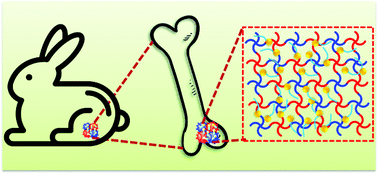Long-term delivery of alendronate through an injectable tetra-PEG hydrogel to promote osteoporosis therapy†
Abstract
Pharmacotherapy for hypercalcemia, which is mainly caused by osteoporosis, is an effective method to regulate the in vivo calcium equilibrium. From this perspective, the development of a minimally invasive gelling system for the prolonged local delivery of bisphosphonates has practical significance in the clinical therapy of bone osteoporosis. Here, a biocompatible and injectable hydrogel based on a uniform tetra-PEG network carrying a PEG-modified alendronate (ALN) prodrug for the localized elution and long-term sustained release of anti-osteoporotic small molecule drugs is reported. The obtained ALN-based tetra-PEG hydrogels exhibit rapid gel formation and excellent injectability, thereby allowing for the easy injection and consequent adaptation of hydrogels into the bone defects with irregular shapes, which promotes the ALN-based tetra-PEG hydrogels with depot formulation capacity for governing the on-demand release of ALN drugs and local reinforcement of bone osteoporosis at the implantation sites of animals. The findings imply that these injectable hydrogels mediate the optimized release of therapeutic cargoes and effectively promote in situ bone regeneration via minimally invasive procedures, which is effective for clinical osteoporosis therapy.

- This article is part of the themed collection: Biomaterials Science Most Popular 2020


 Please wait while we load your content...
Please wait while we load your content...